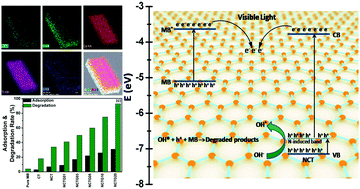当前位置:
X-MOL 学术
›
Mater. Chem. Front.
›
论文详情
Our official English website, www.x-mol.net, welcomes your
feedback! (Note: you will need to create a separate account there.)
Recyclable, bifunctional composites of perovskite type N-CaTiO3 and reduced graphene oxide as an efficient adsorptive photocatalyst for environmental remediation
Materials Chemistry Frontiers ( IF 6.0 ) Pub Date : 2017-09-06 00:00:00 , DOI: 10.1039/c7qm00362e Ashish Kumar 1, 2, 3, 4 , Suneel Kumar 1, 2, 3, 4 , Ashish Bahuguna 1, 2, 3, 4 , Ajay Kumar 1, 2, 3, 4 , Vipul Sharma 1, 2, 3, 4 , Venkata Krishnan 1, 2, 3, 4
Materials Chemistry Frontiers ( IF 6.0 ) Pub Date : 2017-09-06 00:00:00 , DOI: 10.1039/c7qm00362e Ashish Kumar 1, 2, 3, 4 , Suneel Kumar 1, 2, 3, 4 , Ashish Bahuguna 1, 2, 3, 4 , Ajay Kumar 1, 2, 3, 4 , Vipul Sharma 1, 2, 3, 4 , Venkata Krishnan 1, 2, 3, 4
Affiliation

|
Graphene–semiconductor photocatalysts are of utmost interest for achieving visible light activity but there is ambiguity about the role played by graphene in these photocatalysts. Such photocatalysts exhibit both adsorptive and photocatalytic activities towards pollutant degradation. Herein, we report nitrogen doped CaTiO3 (NCT) perovskite coupled with reduced graphene oxide (RGO), RGO–NCT, composites for the first time and utilize them for environmental remediation as an efficient adsorptive photocatalyst. The adsorption and photocatalytic activity were evaluated by investigating the adsorption/degradation of a model dye, methylene blue (MB). In comparison with bare CT and NCT, the RGO–NCT composites exhibit enhanced photocatalytic activity, which could be attributed to the synergistic effect of the adsorption of dye molecules on the RGO surface followed by their degradation under visible light irradiation. In the degradation mechanism, we propose that the degradation of MB is not only due to the dye photosensitization process but also involves the true photocatalytic action of the RGO–NCT composites. The clear role of graphene as an electron acceptor is demonstrated by photoluminescence spectroscopic study. Also, the degradation of a colorless pollutant thiabendazole (TBZ) under visible light irradiation supports our hypothesis. In addition, the commendable stability and recyclability of RGO–NCT photocatalysts demonstrates that these materials can be used as potential, viable and stable photocatalysts for environmental remediation. In principle, we anticipate that our work paves the way for tailoring the photocatalytic activity of perovskite-type semiconductor materials by coupling with graphene for the design of recyclable bifunctional photocatalysts.
中文翻译:

钙钛矿型N-CaTiO 3和还原型氧化石墨烯的可回收,双功能复合材料,可作为有效的环境光吸附光催化剂
石墨烯-半导体光催化剂对于实现可见光活性至关重要,但对于石墨烯在这些光催化剂中的作用尚不明确。这样的光催化剂对污染物降解表现出吸附和光催化活性。在这里,我们报道了氮掺杂的CaTiO 3(NCT)钙钛矿与还原型氧化石墨烯(RGO),RGO-NCT的复合材料,首次将其用于环境修复,作为一种有效的吸附性光催化剂。通过研究模型染料亚甲基蓝(MB)的吸附/降解来评估其吸附和光催化活性。与裸CT和NCT相比,RGO-NCT复合材料表现出增强的光催化活性,这可能归因于染料分子在RGO表面上的吸附及其在可见光照射下的降解的协同作用。在降解机理中,我们提出MB的降解不仅是由于染料的光敏过程,而且还涉及RGO-NCT复合材料的真正光催化作用。通过光致发光光谱研究证明了石墨烯作为电子受体的明确作用。同样,在可见光照射下无色污染物噻菌灵(TBZ)的降解也支持了我们的假设。此外,RGO-NCT光催化剂的值得称赞的稳定性和可回收性表明,这些材料可用作潜在的,可行的和稳定的环境修复光催化剂。原则上,我们预计我们的工作将通过与石墨烯偶联来设计可循环使用的双功能光催化剂,为调整钙钛矿型半导体材料的光催化活性铺平道路。RGO-NCT光催化剂值得称赞的稳定性和可回收性表明,这些材料可用作潜在的,可行的和稳定的环境修复光催化剂。原则上,我们预计我们的工作将通过与石墨烯偶联来设计可循环使用的双功能光催化剂,为调整钙钛矿型半导体材料的光催化活性铺平道路。RGO-NCT光催化剂值得称赞的稳定性和可回收性表明,这些材料可用作潜在的,可行的和稳定的环境修复光催化剂。原则上,我们预计我们的工作将通过与石墨烯偶联来设计可循环使用的双功能光催化剂,为调整钙钛矿型半导体材料的光催化活性铺平道路。
更新日期:2017-10-26
中文翻译:

钙钛矿型N-CaTiO 3和还原型氧化石墨烯的可回收,双功能复合材料,可作为有效的环境光吸附光催化剂
石墨烯-半导体光催化剂对于实现可见光活性至关重要,但对于石墨烯在这些光催化剂中的作用尚不明确。这样的光催化剂对污染物降解表现出吸附和光催化活性。在这里,我们报道了氮掺杂的CaTiO 3(NCT)钙钛矿与还原型氧化石墨烯(RGO),RGO-NCT的复合材料,首次将其用于环境修复,作为一种有效的吸附性光催化剂。通过研究模型染料亚甲基蓝(MB)的吸附/降解来评估其吸附和光催化活性。与裸CT和NCT相比,RGO-NCT复合材料表现出增强的光催化活性,这可能归因于染料分子在RGO表面上的吸附及其在可见光照射下的降解的协同作用。在降解机理中,我们提出MB的降解不仅是由于染料的光敏过程,而且还涉及RGO-NCT复合材料的真正光催化作用。通过光致发光光谱研究证明了石墨烯作为电子受体的明确作用。同样,在可见光照射下无色污染物噻菌灵(TBZ)的降解也支持了我们的假设。此外,RGO-NCT光催化剂的值得称赞的稳定性和可回收性表明,这些材料可用作潜在的,可行的和稳定的环境修复光催化剂。原则上,我们预计我们的工作将通过与石墨烯偶联来设计可循环使用的双功能光催化剂,为调整钙钛矿型半导体材料的光催化活性铺平道路。RGO-NCT光催化剂值得称赞的稳定性和可回收性表明,这些材料可用作潜在的,可行的和稳定的环境修复光催化剂。原则上,我们预计我们的工作将通过与石墨烯偶联来设计可循环使用的双功能光催化剂,为调整钙钛矿型半导体材料的光催化活性铺平道路。RGO-NCT光催化剂值得称赞的稳定性和可回收性表明,这些材料可用作潜在的,可行的和稳定的环境修复光催化剂。原则上,我们预计我们的工作将通过与石墨烯偶联来设计可循环使用的双功能光催化剂,为调整钙钛矿型半导体材料的光催化活性铺平道路。











































 京公网安备 11010802027423号
京公网安备 11010802027423号